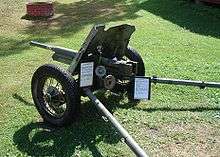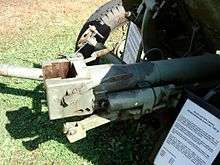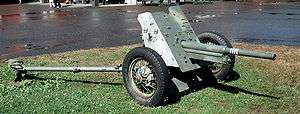45 mm anti-tank gun M1937 (53-K)
| 45 mm anti-tank gun model 1937 (53-K) | |
|---|---|
|
45 mm anti-tank gun M1937, displayed in Finnish Tank Museum in Parola. | |
| Type | Anti-tank gun |
| Place of origin | USSR |
| Production history | |
| Produced | 1937-1943 |
| Number built | 37,354 |
| Specifications | |
| Weight |
combat: 560 kg (1,234 lbs) travel: 1,200 kg (2,645 lbs) |
| Length | 6.4 m |
| Barrel length | 46 calibers (2,070 mm) |
|
| |
| Shell | 45x310 mm. R |
| Caliber | 45 mm (1.77 in) |
| Carriage | split trail |
| Elevation | -8° to 25° |
| Traverse | 60° |
| Rate of fire | 15-20 rpm |
| Muzzle velocity | 760 m/s (2,493 ft/s) |
| Maximum firing range | 4.4 km (2.73 mi) |
The 45 mm anti-tank gun model 1937 (factory designation 53-K) was a light quick-firing anti-tank gun used in the first stage of the German-Soviet War. It was created by Soviet artillery designer M.N. Loginov. Due to insufficient armor penetration it was replaced in service by the long-barreled 45 mm anti-tank gun M1942 (M-42).
History
The gun bearing factory designation 53-K (Cyrillic 53-К) was a combination of a modified carriage of the 37 mm anti-tank gun model 1931 (built according to a documentation bought from Rheinmetall) with a 45 mm barrel. The resulting light semi-automatic anti-tank gun was adopted for Red Army service in 1937, and thus known as "45 mm anti-tank gun M1937" (Russian: 45-мм противотанковая пушка образца 1937 года). These guns were used in the first stage of the German-Soviet War, but their anti-armor capabilities allowed them to fight successfully only with German light tanks and armored personnel carriers. Early models of the Panzer III and Panzer IV could also be knocked out at close range, but this put Soviet artillerymen in greater danger. Due to these circumstances, model 1937 guns were replaced with the all-new design, the more powerful model 1942. The mass production of outdated model 1937 guns was stopped in 1943. The total number of guns produced was 37,354.
Two such guns were employed as an anti-tank platoons, organic to each rifle battalion. Additionally a dozen (12 guns) was in anti-tank battalions at a level of a rifle division. It was also used by separate anti-tank regiments (4-5 batteries of 4 guns each).
Anti-aircraft gun 21-K
The barrel of the 53-K was placed on a pedestal mount and used by the Soviet Navy as an anti-aircraft gun beginning in 1934. It was not very effective in this role since it had to be loaded by hand, which kept its rate of fire down to about 25-30 rounds per minute, and its lack of a time fuze meant that it had to score a direct hit to damage its targets.
Tank gun 20-K
The gun was installed in tanks under the name 45 mm tank gun model 1932 (20-K). It was used on a wide variety of soviet tanks and fired the same ammunition as the anti-tank version. The gun was later improved into the 45 mm tank gun model 1938, which had some new features compared to its towed sibling, the most interesting of which was a TOS stabilized gun sight, allowing for accurate fire while the tank was in motion.Tanks which mounted this gun include:
Ammunition


- Ammunition types:
- Projectile weight (AP): 1.43 kg (3.15 lbs)
- Armor penetration:
- AP shell, 90 degrees:
- at 500 m: 43 mm
- at 1000 m: 32 mm
- AP shell, 60 degrees:
- at 500 m: 38 mm
- at 1000 m: 23 mm
- APCR shell, 90 degrees:
- at 100 m: 88 mm
- at 500 m: 66 mm
- AP shell, 90 degrees:
References
- Shunkov V. N. - The Weapons of the Red Army, Mn. Harvest, 1999 (Шунков В. Н. - Оружие Красной Армии. — Мн.: Харвест, 1999.) ISBN 985-433-469-4
- Koll, Christian (2009). Soviet Cannon - A Comprehensive Study of Soviet Arms and Ammunition in Calibres 12.7mm to 57mm. Austria: Koll. p. 422. ISBN 978-3-200-01445-9.
External links
| Wikimedia Commons has media related to M-37 45 mm anti-tank gun. |
- 45 mm anti-tank gun model 1937 at rustrana.ru (Russian)
- 45 mm anti-tank gun model 1937 manual at xlt.narod.ru (Russian)

